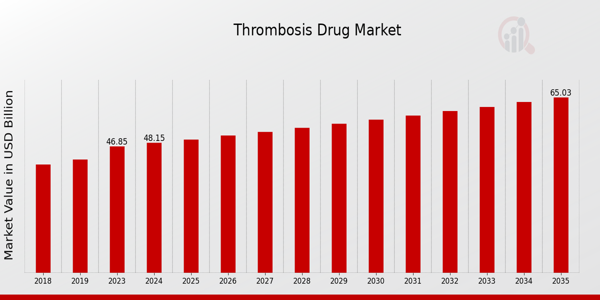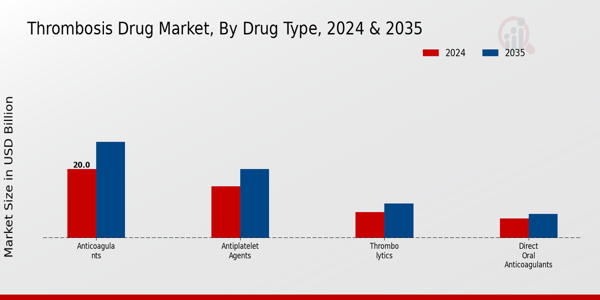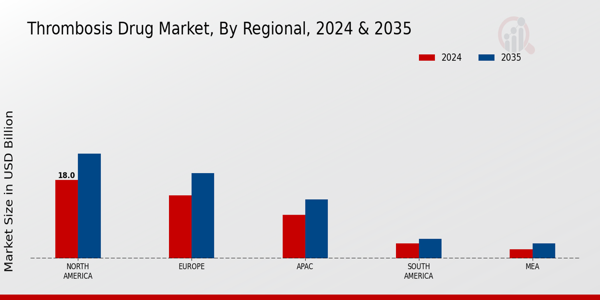Thrombosis Drug Market Overview
The Thrombosis Drug Market Size was estimated at 46.85 (USD Billion) in 2023. The Thrombosis Drug Industry is expected to grow from 48.15(USD Billion) in 2024 to 65.0 (USD Billion) by 2035. The Thrombosis Drug Market CAGR (growth rate) is expected to be around 2.77% during the forecast period (2025 - 2035).
Key Thrombosis Drug Market Trends Highlighted
The Thrombosis Drug Market has grown significantly owing to the increase of thrombotic ailments such as pulmonary embolism and deep vein thrombosis. Thrombotic disorders are becoming increasingly common due to factors such as population aging, changing lifestyles and medical advertising. Campaigns focusing on prevention and better medical equipment boosts the demand for effective treatments and increases early detection of the conditions. In addition, upgrading drug development and delivery devices encourages usage which subsequently cures more people. There are challenges in the market currently but there are many different ways to overcome them.
There is an increased emphasis on personalized medicine which enables the development of targeted therapies which can enhance recovery for a variety of patients. The range of possibilities is substantial due to improved innovative anticoagulants that are safer and more effective than conventional ones. There may be significant market expansion as healthcare systems continue to focus on improving outcomes as opposed to just providing services. Trends show an increase in the use of DOACs because they are more effective than traditional medicines. Patients will benefit from fewer restrictions on their diets and decreased need for blood tests, which will ultimately ease the work of health professionals.
Furthermore, the role of mobile health applications is critical in aiding patients take control of their health and integrate with digital health technologies to actively participate in the management of thrombosis. These developments indicate positive changes in the treatment framework and managing patients’ unmet needs in the field of thrombosis.

Source: Primary Research, Secondary Research, MRFR Database and Analyst Review
Thrombosis Drug Market Drivers
Increasing Incidence of Thromboembolic Disorders
The Global Thrombosis Drug Market Industry is significantly driven by the rising prevalence of various thromboembolic disorders, including deep vein thrombosis (DVT), pulmonary embolism (PE), and atrial fibrillation (AF). These conditions have been linked to an aging population and lifestyle factors such as obesity, sedentary behavior, and smoking. Additionally, as populations grow older, there is a corresponding increase in the number of patients at risk for thrombotic events.This demographic shift leads to a greater demand for effective thrombosis therapies and medications. Healthcare providers are therefore under pressure to develop new and improved strategies for managing these potentially life-threatening conditions.
Moreover, heightened awareness and screening practices among healthcare professionals are contributing to the early detection of thromboembolic disorders. With advancements in diagnostic technologies and an increased focus on preventive measures, the demand for various thrombosis medications is expected to rise even further.Overall, the growing burden of thromboembolic diseases inherently fuels the market's expansion, making it a prominent driver in the Global Thrombosis Drug Market Industry.
Advancements in Anticoagulant Medications
The continuous innovation in anticoagulant medications is a key factor propelling the Global Thrombosis Drug Market Industry. The introduction of novel oral anticoagulants (NOACs) and direct oral anticoagulants (DOACs) offers enhanced safety and efficacy compared to traditional therapies. These newer medications provide physicians with better options in managing thromboembolic conditions while reducing the need for regular monitoring. As these advanced therapies become more accessible, they are likely to gain significant traction among both healthcare providers and patients, further stimulating market growth.
Rising Awareness and Education on Thrombosis Management
Increased awareness around the risks and management of thrombosis is actively driving growth in the Global Thrombosis Drug Market Industry. Campaigns aimed at educating both healthcare professionals and the public about the signs, symptoms, and treatment options available are critical in altering perceptions around thromboembolic disorders. As more individuals learn about the importance of early intervention and preventative care, they are more likely to seek medical advice, contributing to increased diagnosis and treatment rates.The greater the awareness, the more robust the demand for effective thrombosis medications, thereby shaping the future landscape of this market.
Thrombosis Drug Market Segment Insights
Thrombosis Drug Market Drug Type Insights
The Global Thrombosis Drug Market has shown substantial growth, particularly within the Drug Type segmentation which encompasses Anticoagulants, Antiplatelet Agents, Thrombolytics, and Direct Oral Anticoagulants. As of 2024, Anticoagulants are projected to hold a significant market share valued at 20.0 USD Billion, expected to expand to 28.0 USD Billion by 2035. This class of drugs is critical in managing and preventing thrombotic events, which underscores their dominance within the market. Anticoagulants are essential due to their widespread application in conditions such as atrial fibrillation and venous thromboembolism, making them a cornerstone of thrombotic therapy. Antiplatelet Agents are also substantial players, valued at 15.0 USD Billion in 2024, with expectations of rising to 20.0 USD Billion by 2035. Their role in preventing platelet aggregation during acute events, such as heart attacks and strokes, highlights their significance in the healthcare landscape. While they don't dominate the market like Anticoagulants, they still possess a critical function in comprehensive thrombus management strategies.
Moving forward, Thrombolytics stand at a valuation of 7.5 USD Billion in 2024, anticipated to grow to 10.0 USD Billion by 2035. These agents are primarily used in emergency settings to dissolve clots promptly, thus playing an essential role in acute thrombotic scenarios. Though they represent a smaller segment compared to Anticoagulants and Antiplatelet agents, their therapeutic importance in critical care settings cannot be understated.Direct Oral Anticoagulants, with a valuation of 5.65 USD Billion in 2024 and a growth target of 7.0 USD Billion by 2035, are gaining traction due to their ease of use and favorable pharmacological profile, which appeals to both patients and healthcare providers. Despite their smaller market share, their growing adoption reflects a shift towards newer, more patient-friendly formulations in thrombosis treatment.
In summary, the Drug Type segmentation within the Global Thrombosis Drug Market showcases a robust framework characterized by the importance of Anticoagulants, which dominate the landscape due to their widespread application. Antiplatelet Agents, while significant, serve as a supportive pillar in thrombus management. Thrombolytics and Direct Oral Anticoagulants, although smaller in overall market share, provide essential therapeutic functions that cater to specific clinical needs, reinforcing the diverse and critical nature of the Global Thrombosis Drug Market. Insights from Global Thrombosis Drug Market revenue illustrate the substantial potential for growth across these categories, influenced by evolving medical practices, increased awareness of thrombosis conditions, and ongoing advancements in drug formulations, indicating opportunities for market players to innovate and expand their portfolios within this vital industry.

Source: Primary Research, Secondary Research, MRFR Database and Analyst Review
Thrombosis Drug Market Route of Administration Insights
The Global Thrombosis Drug Market has seen significant growth, with the overall market valued at 48.15 USD Billion in 2024. The Route of Administration is a critical aspect of this market, as it includes various methods through which thrombosis medications are administered. This segmentation comprises Oral, Injectable, and Intravenous routes, each catering to different patient needs and treatment protocols. The Oral administration method often holds a majority share due to its ease of use and patient compliance, making it a preferred choice for many healthcare providers.Injectable routes are significant as they allow for rapid absorption and are commonly used in acute care settings.
Intravenous administration often dominates hospital environments where immediate and controlled drug delivery is vital. The diversification among these routes offers healthcare professionals precise options, thereby enhancing treatment efficacy and patient outcomes. Market trends show a steady preference for more convenient and less invasive administration methods, driving innovation within the Global Thrombosis Drug Market. As a result, understanding the complexities and dynamics of the Route of Administration enables stakeholders to better align their strategies with evolving market demands.
Thrombosis Drug Market Therapeutic Application Insights
The Global Thrombosis Drug Market revenue is primarily driven by the Therapeutic Application segment, which is expected to be a significant contributor as the market progresses towards an anticipated valuation of 48.15 billion USD in 2024. This segment encompasses various applications vital for treating conditions related to blood clots, including Deep Vein Thrombosis, Pulmonary Embolism, and Coronary Artery Disease. Each of these conditions plays a crucial role in the market, with Deep Vein Thrombosis highlighting a critical need for effective treatment options given its high prevalence and complications associated with it.
Similarly, Pulmonary Embolism presents severe risks, making effective drug treatments essential for patients' survival. Moreover, Coronary Artery Disease remains a dominant force within this segment, as lifestyle changes increase its incidence, further emphasizing the demand for effective thrombosis treatments. The overall Global Thrombosis Drug Market statistics reflect an increasing awareness and need for targeted therapies to manage these serious conditions, showcasing growth drivers driven by advancing medical research and improved healthcare access.However, challenges such as rising treatment costs and stringent regulatory frameworks are present, posing potential barriers to market growth. Nonetheless, this market segment continues to offer opportunities for innovation and development in drug formulations.
Thrombosis Drug Market Patient Age Group Insights
The Global Thrombosis Drug Market exhibits a diverse segmentation based on Patient Age Group, underscoring its critical role in addressing the needs of various demographics. In 2024, the market is projected to be valued at 48.15 USD billion, with a notable increase anticipated by 2035. Within this segment, the Adult age group holds significant importance, reflecting the high prevalence of thrombotic disorders among this population. Furthermore, the Geriatric category is increasingly relevant, given the rising age of the global population, which correlates with higher incidences of thrombosis-related health issues.
Pediatric patients, while representing a smaller proportion, are equally important due to the unique challenges in treatment and the need for specialized formulations. Understanding the Global Thrombosis Drug Market data related to these age categories is essential for effective marketing strategies and product development. The market growth is influenced by increasing awareness about thrombosis prevention and treatment, although challenges such as high drug costs and regulatory hurdles persist. Overall, the Global Thrombosis Drug Market statistics illuminate the demand for innovative treatments tailored to the specific needs of each age group.
Thrombosis Drug Market Regional Insights
The Regional segment of the Global Thrombosis Drug Market shows significant insights regarding market distribution and growth. In 2024, North America leads with a valuation of 18.0 USD Billion, reflecting its majority holding and the region's advanced healthcare infrastructure, which supports the strong demand for thrombosis management. Europe follows closely with a valuation of 14.5 USD Billion, indicating a robust market driven by a rapidly aging population and increasing awareness of chronic diseases. The APAC region, valued at 10.0 USD Billion in 2024, shows great potential for growth due to expanding healthcare access and the rising burden of cardiovascular diseases.
South America and MEA, with valuations of 3.5 USD Billion and 2.15 USD Billion respectively, illustrate smaller yet important markets, driven by improving healthcare systems and increasing investments in pharmaceutical advancements. The Global Thrombosis Drug Market revenue in these regions is shaped by unique market dynamics, health policies, and demographic factors, making regional insights crucial for understanding the overall market landscape and opportunities that lie ahead.

Source: Primary Research, Secondary Research, MRFR Database and Analyst Review
Thrombosis Drug Market Key Players and Competitive Insights
The competitive insights of the Global Thrombosis Drug Market reveal a dynamic landscape characterized by innovation, strategic collaborations, and varying market strategies employed by key players. This market has witnessed an increased focus on research and development, aimed at improving therapeutic outcomes for patients dealing with thromboembolic disorders. The global push towards enhancing treatment efficacy and minimizing adverse effects has spurred numerous pharmaceutical companies to invest heavily in this sector. Identifying and acting upon unmet needs in the market has allowed leading companies to carve out significant market shares. Moreover, trends towards personalized medicine and the advent of novel therapeutic agents, including anticoagulants and antiplatelet agents, are shaping competitive dynamics.
The evolving regulatory environment and growing awareness about the importance of thrombosis management also play essential roles in molding the competitive strategies of firms within this space. Merck holds a distinctive presence in the Global Thrombosis Drug Market, with a robust portfolio of products designed to address various thrombosis-related conditions. The company's strengths include its strong R&D capability, enabling it to bring innovative therapies to the market swiftly. Merck's commitment to improving patient outcomes through enhanced treatment options equips it to maintain a competitive edge.
The company's established distribution networks and collaborations with healthcare providers also facilitate better market penetration and customer outreach. Furthermore, Merck's strategic alliances with research institutions foster collaboration in drug development, enhancing its ability to introduce cutting-edge solutions. This strategic positioning, combined with a strong brand reputation in the healthcare sector, accentuates Merck's competitive advantage in catering to a growing patient population in need of effective thrombosis management.In the Global Thrombosis Drug Market, Roche stands out through its solid reputation for high-quality pharmaceuticals and commitment to innovation.
The company has established itself as a key player by focusing on targeted therapies that cater to specific patient needs, enabling enhanced treatment outcomes. Roche's strength lies in its comprehensive understanding of thrombotic disorders and its ability to develop advanced diagnostic and treatment options that complement each other. The company's investment in personalized medicine and innovation showcases its dedication to addressing the complexities associated with thrombosis. Moreover, Roche benefits from its extensive clinical trial networks, which help with fast-tracking drug approvals and bring novel therapies to market more efficiently. This strategic emphasis on integrating diagnostics with therapeutics allows Roche to leverage its capabilities effectively, maintaining a competitive stance in a rapidly evolving market landscape.
Key Companies in the Thrombosis Drug Market Include
- Merck
- Roche
- Sanofi
- Novartis
- GlaxoSmithKline
- Boehringer Ingelheim
- Eli Lilly
- Pfizer
- Bristol Myers Squibb
- AstraZeneca
- Takeda
- Abbott
- Amgen
- Bayer
- Johnson and Johnson
Thrombosis Drug Market Industry Developments
Recent developments in the Global Thrombosis Drug Market include significant advancements and changing dynamics among key players such as Merck, Roche, Sanofi, Novartis, GlaxoSmithKline, Boehringer Ingelheim, Eli Lilly, Pfizer, Bristol Myers Squibb, AstraZeneca, Takeda, Abbott, Amgen, Bayer, and Johnson & Johnson. There have been ongoing efforts to enhance therapeutic efficacy and safety profiles of existing anticoagulants, with companies investing in innovative drug formulations and delivery methods. In addition, the market has witnessed notable mergers and acquisitions, with some companies strategically consolidating to strengthen their portfolio and market reach, focusing on expanding their product pipeline in thrombosis management.
For instance, recent partnerships and collaborative agreements among leading firms have intensified competition and driven research initiatives, notably in the realms of personalized medicine. Furthermore, the growing prevalence of thromboembolic disorders, fueled by lifestyle changes and an aging global population, is propelling market growth and prompting continued investment in research and development. The competitive landscape is evolving rapidly, and companies are adapting their strategies to align with market demands and regulatory frameworks, ultimately shaping the future of thrombosis treatment options.
Thrombosis Drug Market Segmentation Insights
Thrombosis Drug Market Drug Type Outlook
- Anticoagulants
- Antiplatelet Agents
- Thrombolytics
- Direct Oral Anticoagulants
Thrombosis Drug Market Route of Administration Outlook
- Oral
- Injectable
- Intravenous
Thrombosis Drug Market Therapeutic Application Outlook
- Deep Vein Thrombosis
- Pulmonary Embolism
- Coronary Artery Disease
Thrombosis Drug Market Patient Age Group Outlook
- Pediatric
- Adult
- Geriatric
Thrombosis Drug Market Regional Outlook
- North America
- Europe
- South America
- Asia Pacific
- Middle East and Africa
|
Report Attribute/Metric
|
Details
|
|
Market Size 2023
|
46.85(USD Billion)
|
|
Market Size 2024
|
48.15(USD Billion)
|
|
Market Size 2035
|
65.0(USD Billion)
|
|
Compound Annual Growth Rate (CAGR)
|
2.77% (2025 - 2035)
|
|
Report Coverage
|
Revenue Forecast, Competitive Landscape, Growth Factors, and Trends
|
|
Base Year
|
2024
|
|
Market Forecast Period
|
2025 - 2035
|
|
Historical Data
|
2019 - 2024
|
|
Market Forecast Units
|
USD Billion
|
|
Key Companies Profiled
|
Merck, Roche, Sanofi, Novartis, GlaxoSmithKline, Boehringer Ingelheim, Eli Lilly, Pfizer, Bristol Myers Squibb, AstraZeneca, Takeda, Abbott, Amgen, Bayer, Johnson and Johnson
|
|
Segments Covered
|
Drug Type, Route of Administration, Therapeutic Application, Patient Age Group, Regional
|
|
Key Market Opportunities
|
Rising prevalence of thrombotic disorders, Increased demand for novel anticoagulants, Growth in geriatric population, Advancements in personalized medicine, Expansion in emerging markets
|
|
Key Market Dynamics
|
Increasing prevalence of thrombosis, Advancement in drug formulations, Growing geriatric population, Rising healthcare expenditure, Enhanced awareness and diagnosis
|
|
Countries Covered
|
North America, Europe, APAC, South America, MEA
|
Frequently Asked Questions (FAQ) :
The Thrombosis Drug Market is expected to be valued at 48.15 USD Billion in 2024.
The market is projected to reach a value of 65.0 USD Billion by 2035.
The expected CAGR for the Global Thrombosis Drug Market from 2025 to 2035 is 2.77%.
North America is expected to dominate the market, projected to reach 24.0 USD Billion by 2035.
Anticoagulants are projected to have a market share valued at 20.0 USD Billion in 2024.
The Antiplatelet Agents segment is expected to be valued at 20.0 USD Billion in 2035.
The Thrombolytics segment is expected to be valued at 7.5 USD Billion in 2024.
Direct Oral Anticoagulants are projected to reach a market value of 7.0 USD Billion by 2035.
Major players in the market include Merck, Roche, Sanofi, Novartis, and GlaxoSmithKline.
The APAC region is expected to have a market size of 13.5 USD Billion by 2035.

















